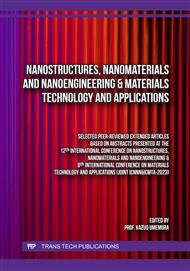[1]
T.S. Rad, A. Khataee, F. Vafaei and SP. Pouran. Chemosphere. Vol. 274 (2021), p.129988.
Google Scholar
[2]
T.S. Rad, Z. Ansarian, R.D.S. Soltani, A. Khataee, Y. Orooji and F. Vafaei. J. Hazard. Mater. Vol. 399 (2020), p.123062.
DOI: 10.1016/j.jhazmat.2020.123062
Google Scholar
[3]
Q. Wang, W.J. Jia, B.C. Liu, A. Dong, X. Gong, C.Y. Li, P. Jing, Y.J. Li, G.R. Xu and J.J. Zhang. Mater. Chem. A. Vol. 41 (2013), pp.12732-12741.
Google Scholar
[4]
X. Gu, Z.X. Xu, L.P. Gu, H.Y. Xu, F.X. Han, B. Chen and X.J. Pan. Environ. Chem. Lett. Vol. 19 (2021) pp.167-187.
Google Scholar
[5]
S. Korkut, S. Uzuncar, M.S. Kilic and B. Hazer.Instrum. Sci. Technol. Vol. 44 (2016), pp.614-628.
Google Scholar
[6]
D.B. Hazer and B. Hazer.J. Polym. Res Vol. 18 (2011), pp.251-262.
Google Scholar
[7]
F.D. Prado, H.F. Andersen, M. Taeño, J.P. Mæhlen, J.R. Castellanos, D. Maestre, S. Karazhanov and A. Cremades. Scientific Reports. Vol. 10 (2020), pp.5503-5508.
DOI: 10.1038/s41598-020-62505-x
Google Scholar
[8]
M. Ajmal, F. Aftab, I. Bibi, M. Iqbal, J. Ambreen, H.B. Ahmad, N. Akhtar, A. Haleem and M. Siddiq, J. Porous Mater. Vol. 26 (2019), pp.281-290.
DOI: 10.1007/s10934-018-0654-8
Google Scholar
[9]
M. Tercan, S. Demirci, O. Dayan and N. Sahiner.New J. Chem. Vol. 44 (2020), p.4417–4425.
Google Scholar
[10]
N. Sahiner, S. Yildiz and H.J.A.C.B.E. Al-Lohedan.Applied Catalysis B: Environmental. Vol. 166 (2015), pp.145-154.
Google Scholar
[11]
A. Srivastava, E. Jain and A. Kumar.Materials Science and Engineering: A. Vol. 464 (2007), pp.93-100.
Google Scholar
[12]
Y. Saylan and A. Denizli.Gels Vol. 5 (2019), pp.1-20.
Google Scholar
[13]
A. Haleem, Z. Haider, R.U.S. Ahmad, U.P. Claver, A. Shah, G. Zhao and W.D. He. Int. J. Energy Res. Vol. 44 (2020), pp.8442-8454.
Google Scholar
[14]
C.S. Hu, H.J. Li, Y.J. Wang, A. Haleem, X.C. Li, M. Siddiq and W.D. He. ACS Appl. Energy Mater. Vol. 10 (2019), pp.7554-7563.
DOI: 10.1021/acsaem.9b01530
Google Scholar
[15]
Z. Haider, A. Haleem, R.U.S. Ahmad, U. Farooq, L. Shi, U.P. Claver, K. Memon, A. Fareed, I. Khan, M. MKarmah, M.K. Mbogba, S.M.C. Hossain, F. Farooq, W. Ali, M. Abid, A. Qadir, W.D. He, J.K. Luo and G. Zhao.Nano Energy. Vol. 68 (2020), p.104294.
DOI: 10.1016/j.nanoen.2019.104294
Google Scholar
[16]
J.Y. Wang, X.X. Guo, J. Chen, S.C. Hou, H.J. Li, A. Haleem, S.Q. Chen and W.D. He. Mater. Adv. Vol. 2 (2021), pp.3088-3098.
Google Scholar



